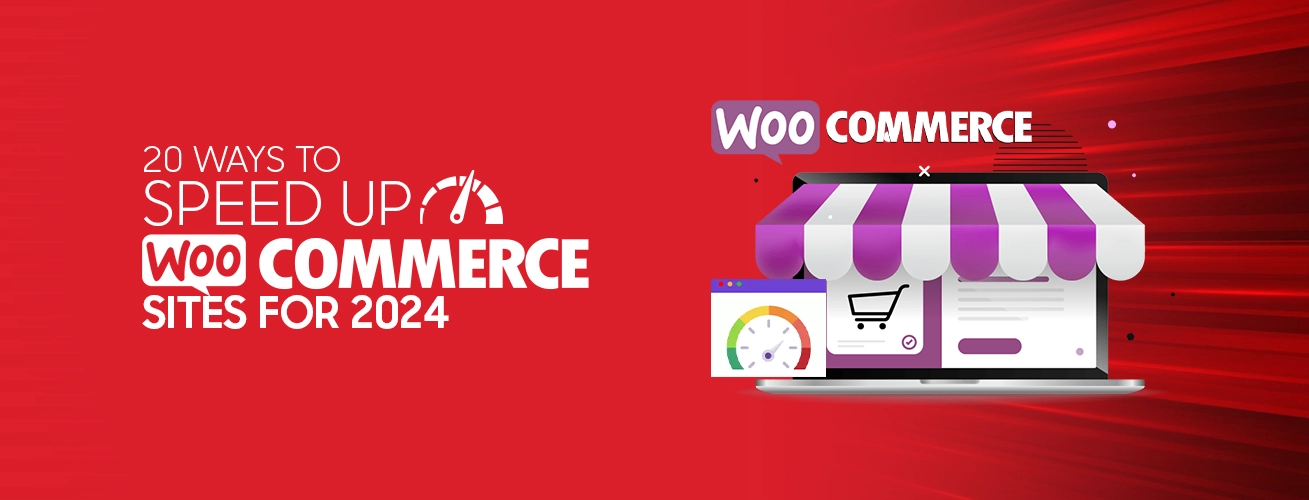20 Ways to Speed Up WooCommerce Sites for 2024
Do you know if your WooCommerce site takes more than 3 seconds to load, you will have a poor ranking on Search Engine Result Pages (SERPs)? Yes, it is a proven fact. Be mindful, if you are running an eCommerce business.
If you want to remain competitive, you need a fast fast-loading WooCommerce site for better user experience, seamless shopping journey, increased SEO, enhanced ROI, and greater revenue and profit. In this fast-paced digital world, speed is money because attention spans have been reduced and visitors choose whatever is available without waiting too long.
Many reasons can slow down WooCommerce sites. You need to know these reasons and their solutions for offering seamless and optimum user experience. You can ill-afford ignoring them because fierce competition in the eCommerce world means that you need to provide high-resolution images, user reviews, real-time inventory, and personalized experience to outflank your competitors.
In this article, we will share top WooCommerce speed optimization tips so that you can overcome slow loading and deliver a more enjoyable and smoother shopping experience for your customers and potential customers.
First, we share some facts to demonstrate how important speed is for your WooCommerce site.
Why Do You Need to Speed Up Your WooCommerce Site?
Here are some facts that show how poor speed can impact your WooCommerce business.
- A study shows that when a WooCommerce site takes more than 6 seconds to load, visitors experience stress that is equivalent to taking a math test or watching a horror movie.
- A survey reveals that more than 80% of visitors are annoyed more by slow-loading WooCommerce sites than by a site that is down temporarily.
- Another survey shows that WooCommerce website speed influences the decisions of 70% of visitors when it comes to online shopping.
- The survey further adds that more than 83% of visitors want WooCommerce sites to open in less than 3 seconds.
- Online shoppers say that they stop a brand that delivers a bad online shopping experience, and more than half inform others about their bad experience.
These are some of many studies and surveys that clearly show that WooCommerce site speed can have a determinant effect on your online business because it can influence directly user experience, conversion rate, search engine ranking, brand reputation, and site performance.
More importantly, the speed of your WooCommerce store has a direct link with Google’s Core Web Vitals. Let’s see how they influence one another.
Google’s Core Web Vitals and Their Significance in Measuring the Performance of Your WooCommerce Site:
Google’s Core Web Vitals are a set of metrics that are used to measure the user experience of web pages. Their role in measuring the performance and consequently improving the performance of webpages is becoming ever more crucial. Here are some web vitals that Google uses to analyze web pages.
-
FID or First Input Delay:
FID is a measurement of the responsiveness of your WooCommerce site to user interactions. The lower the FID, the better. Lower FID implies that users can quickly perform tasks on your site such as navigating different sections of the site or completing a cart for online shopping.
-
CLS or Cumulative Layout Shift:
CLS is concerned with the stability of your web pages when the website is loading. The lower the CLS, the more stability, indicating that elements on your websites don’t shift unexpectedly. Lower CLS thus allows you to deliver a smoother online shopping experience.
-
LCP or Largest Contentful Paint:
LCP measures how long it takes the largest content elements to load on your websites. The faster the LCP, the better. Fast LCP indicates that the largest content elements such as images or featured content load quickly, offering a better user experience and user engagement.
Now cut the crap and discuss our main point: how to optimize WooCommerce site speed.
20 Powerful Ways to Speed Up Your WooCommerce Site in 2024:
Here are some practical tips and tricks that can help you optimize the speed, performance, security, and support of your WooCommerce site.
#01: Compressing and Optimizing Images:
Needless to say, high-resolution images on your site are key to providing vital information concerning your products. However high-resolution images are usually of large sizes, contributing to slowing down your WooCommerce site. They can extend the loading times of websites, impacting adversely on user experience.
You need to sort this issue out if you want to deliver a seamless user experience. There are many options out there to accomplish this. For instance:
First, you can use multiple image compression plugins available in the WordPress repository. For example, Smush, ShortPixel, and Imagify are some worth-mentioning tools to compress images without compromising their quality.
Second, lazy loading is another image compression and optimization strategy. Lazy loading helps your WooCommerce site to upload images that come into view of visitors. This strategy can help you reduce page loading time significantly, allowing you to increase WooCommerce speed. You can use this option for both videos and images.
#02: Keeping Plugin Count Optimum:
When you start using WooCommerce solutions for your eCommerce business, you will soon realize that the free version does not provide all the essential capabilities. You need some plugins and extensions to compensate for that. You can also purchase some third-party extensions as well. But installing plugins or extensions causes two kinds of problems:
First, you need to invest money that can cause problems, if you are running a startup or small business.
Second, the installation of too many plugins can significantly reduce the speed of the WooCommerce site. You will end up having a much higher loading time.
Solution?
First, remove all unwanted and outdated plugins. It will help you boost your speed and performance.
Second, install as minimum plugins as possible. You need to find WooCommerce or third-party extensions that offer all-in-one capabilities such as SEO, bloated, CPU, backup, and more.
#03: Choosing a Reliable WooCommerce Hosting Provider:
WooCommerce hosting provider plays a determinant role in the speed and performance of your website or online store. Therefore, you need to be very careful when it comes to choosing a WooCommerce hosting solution. The hosting provider must offer the following features:
First, WooCommerce hosting must be designed specifically for eCommerce, so that you can deliver a seamless online shopping experience.
Second, it must offer sufficient resources and a dedicated IP address so that you can provide an uninterruptible user experience, no matter how many products you display or how much traffic you handle.
Third, the hosting should also offer advanced caching technology, allowing you to speed up WooCommerce websites.
Fourth, the built-in Content Delivery Network feature is also essential, helping you to provide fast loading speed for your customers across the globe.
These are some of the offerings you look into before finalizing the WooCommerce hosting provider.
#04: Using Content Delivery Network or CDN:
Deploying a Content Delivery Network or CDN can help you boost your WooCommerce significantly. CDN stores static assets such as images across a global network of servers. When a visitor visits your online store, these assets are delivered from the nearest server, allowing you to enhance webpage loading speed and deliver a better user experience. CDN also delivers protection from DDoS attacks and other cybersecurity threats.
Some WooCommerce hosting providers such as Hostinger offer a built-in CDN option. You may choose other CDN services such as jsDelivr, CloudFlare, KeyCDN, and StackPath. Whatever option you choose, the CDN must be your priority to ensure WooCommerce website speed and performance optimization.
#05: Clearing WooCommerce Database:
WooCommerce Site database can contain multiple kinds of data such as content and transaction data. When this data piles up, it can slow down your website considerably. You need to remove excessive junk from the database and clean it regularly. This will help you improve WooCommerce store speed. You can also stop non-critical functions to further boost the performance and speed of your website such as auto-generated counters.
#06: Continuous Measuring and Monitoring Website Speed:
Testing website speed is important because if you don’t know the problem, you cannot fix it. Therefore, keeping an eye on the speed of the website through continuous measuring and monitoring is a key pillar of strategy to boost the speed of your WooCommerce site.
There are many online tools available that allow you to test the speed of your website. For instance, Google PageSpeed Insights and Pingdom are two popular speed-measuring tools.
Google PageSpeed Insights is one of the best available options. It is an official tool by Google and lets website owners calculate speed on next-generation image format, size of images, proper coding, and more. This tool evaluates the speed and performance of sites based on Core Web Vitals which we have discussed above.
When you test your website speed on this tool, you will end up having cumulated scores for both mobile and desktop. The tool gives a score from 1 to 100. If your website scores more than 90, you don’t need to launch a campaign for WooCommerce website speed optimization. However, if you score less than 90, you need to hire WooCommerce speed optimization service providing firms to speed up your website.
#07: Stripping Unused Scripts and Stylesheets:
Almost all WordPress plugins and themes load scripts and stylesheets on all of the web pages of websites. Sometimes, these scripts and stylesheets are loaded unnecessarily, leading to higher loading times. If you remove these unused scripts, it will lead to improved website speed and performance.
For instance, there is no need at all to load payment-related scripts on the home page or shop pages. They are needed on the checkout and order confirmation pages. You need to restrict these loads on these pages. This removal of unnecessary loads allows you to reduce bloat on your website. This will enable your websites to spend less time on spinning up sites.
If you don’t know what scripts to remove and which one needs to be left, you can use the Asset CleanUp: Page Speed Booster plugin. This plugin helps you remove styles and scripts which are not necessary. Here, it should be noted that you first optimize your homepage and landing pages. These webpages need to remove all of the unnecessary scripts and stylesheets so that you can optimize WooCommerce site speed.
#08: Enabling Caching:
Enabling caching is another way to speed up the WooCommerce site. Normally, when someone visits your website, complete data from your website is downloaded to their browser. Enabling caching helps you to store a copy of the entire data or static file on the disk. So, whenever they visit your website again, the web pages load quickly, allowing you to deliver a more seamless online shopping experience.
You can use various options in this regard, but server caching is generally preferred because it helps you store all caching on your end.
#09: Installing a Faster WooCommerce Theme:
If your website is scoring low on Google PageSpeed Insights, you first check whether your theme is slow or not. You should know that if your theme is heavy and slow-responding, you cannot increase the speed of your WooCommerce site, no matter how much you invest your time and resources in various speed-enhancing tips and tricks.
But how you can know that your WooCommerce theme is slow-responding? Let’s discuss it.
Themes are important for any WordPress site, and WooCommerce is no different. But if you install a theme that is heavy and poorly coded, the load speed of your website will be agonizingly slower. The solution is finding a theme that is well-coded and light.
Here are key considerations before finalizing the WooCommerce theme:
First, choose a theme with a simple and minimalistic design because themes with fancy designs are often written with unoptimized coding.
Second, the size of the theme should be less than 1 MB, ideally, it should be less than 500 KB.
Third, the theme should be responsive. In other words, the theme should perform equally well on all kinds of devices such as mobile, desktops, tablets, and the like.
#10: Deleting Old Revisions:
If you have been running a WooCommerce site for a while, all of its pages, posts, and products would contain old revisions. These old revisions should be deleted to enhance the speed and performance of your website.
You can use various options in this regard, such as WP Rocket, this plugin is popular among WooCommerce web owners because it provides one of the easiest ways to delete old revisions.
#11: Optimizing the Code:
Improving the code for your WooCommerce is another important step in enhancing the speed of your website. Here are some ways you can optimize your code:
Minification:
Minification is the removal of all formatting from website files that are used to make code readable such as indents and comments. Since browsers can read code with any formatting needs, therefore, you don’t need to make it larger and slower to download.
Delaying and Deferring JavaScript:
Delaying and deferring is an important tactic to eliminate render-blocking resources. This helps the browser to keep ignoring less important files such as analytics scripts, and keep focusing on more important files essential for the quick loading of webpages.
#12: Deploying Higher PHP Version:
The latest and updated PHP version is a crucial requirement for a smooth and seamless shopping experience. You need to check your PHP version, if it is old and outdated, get it updated as soon as possible.
#13: Limiting External Resources:
The external resource can be anything that is not on your WooCommerce server, be it a script, a font, or a stylesheet. Since you cannot optimize every external resource, it is very important to limit them because they can slow down your website.
You can use credible sources such as Google Fonts to reduce dependency. These credible sources of external resources can take care of everything that can impact the speed of your WooCommerce store.
#14: Optimizing Widget and Social Media Sharing Tools:
It is generally the case that social media widgets such as Facebook, LinkedIn, and X(Twitter) can lead to slowing down your website. They slow down by downloading external resources, adding HTTP requests, enhancing the size of the web pages, and increasing internal dependency on CDN.
#15: Enhancing WordPress Memory Limit:
Usually, WordPress allocates 32MB of memory for PHP. When there are some crunches, this memory limit increases to 40MB for a single site or 64 MB for a multi-site. This memory is not enough for WooCommerce sites. You can end up having error messages such as “Allowed memory size of xxxxxx bytes exhausted”
It is recommended that you enhance the WordPress memory limit to 256MB at least. And more importantly, do keep a backup before editing any file.
#16: Implementing HTTP2:
Needless to say, HTTP protocol is one the most fundamental building blocks of internet connections. This is the reason why we use http:// before every web address. However, improvement in internet technology means that there are newer HTTP versions with improved transmission speed. HTTP/2 is one of them. It is way faster than HTTP.
If you are running an online business, you must use HTTP/2 because it can protect sensitive data such as credit card information and other sensitive payment data. You need to make sure that your WooCommerce has HTTP/2, it will give you a significant speed boost.
We also recommend HTTP3 because it offers you massive performance and cutting-edge security capabilities. If your WooCommerce site hosting provider does not support it, you should consider changing it to get benefits from HTTP3.
#17: Managing Affiliated Ads and Products:
Managing affiliated ads and products is also a key strategy to increase WooCommerce site website speed. You need to use a single network to run ads on your WooCommerce site, don’t go for ad placement. Furthermore, affiliated ads are in the form of images that are hosted on external services. Resultantly, they can reduce the speed of your website. You had better host images yourself and improve your speed by optimizing images and decreasing DNS queries.
#18: Optimizing WooCommerce Site for Mobile-First Experience:
Statista reports that there are 5.36 billion internet users today. In other words, around 66% population is connected to the world web and has internet access. Out of all the devices that can be used to access the internet, the mobile phone is the most popular. Since 2019, smartphone users are the majority of internet users, accounting for 52.6% of total pageviews. They are also responsible for 74% of retail site traffic worldwide, allowing businesses and firms to exploit this huge potential.
One way to capture this lucrative market is to create a WooCommerce website that is mobile responsive. You can achieve this end in the following ways:
First, choose a WooCommerce site theme that is mobile responsive. Some mobile-responsive WooCommerce theme examples are Botiga, Page Builder Framework, Kadence, and Blocky.
Second, mobile users don’t like to scroll down, therefore, keep your website pages as lean as possible.
Third, install WooCommerce Product Search to help visitors search for products of their choice as easily as possible.
Fourth, streamline your shopping checkout procedure. The fewer the steps, the better. You can use WooCommerce plugins to deliver a seamless shopping experience such as WooCommerce Social Login, Variation Swatches, and Photos, One Page Checkout, and Checkout Field Editor, to name a few.
#19: Optimizing WooCommerce Admin Dashboard:
To speed up the WooCommerce site, it is always important to optimize both the front and back end. You can start with optimizing front ends such as front-end scripts, and modifying other elements.
#20: Removing Bloats and Updating Everything
Last but not least, you make sure that your WordPress, WooCommerce, themes, and plugins are updated. If developers are not supporting the newest edition, change it now! Similarly, if your themes or plugins are causing unnecessary bloats, you must start searching for better alternative options.
Final Words:
The eCommerce world is undergoing rapid transformation. The explosive growth of AI and other technological advancements means that you need to be ahead of the curve to stay competitive in the marketplace. Optimizing your WooCommerce site is one such step. Many reasons cause slowing down your website, but you can overcome them by some practical measures. For instance, installing the latest PHP version, deploying a mobile-responsive and light-weighted WooCommerce site theme, and keeping the plugin and extensions to the minimum possible level are some of the many WooCommerce site speed optimization tips. We have attempted to give you the best material enabling you to understand how to speed up the WooCommerce store. We do hope that this article will help you to speed up your WooCommerce store.




